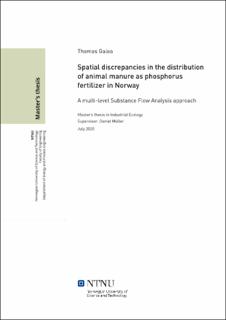| dc.description.abstract | Many countries rely today on the import of non-renewable phosphate rock as a source of phosphorus
(P) for fertilizers used in food production. Secondary fertilizers in the form of organic sources,
like animal manure, are at the same time available in quantities that could meet crop fertilization
requirements, but spatial discrepancies in the distribution of these resources (among other challenges)
makes them an unattractive alternative to primary fertilizers. This spatial segregation needs
to be addressed in order to foster the re-distribution of organic P-fertilizer and alleviate the demand
for mineral-P. System-based approaches can contribute to a refined understanding of the causes of
those spatial discrepancies, by a quantification of the stocks and flows of nutrients at different scales.
In this project, Norway was used as a case study to conduct a multi-level Substance Flow Analysis
(SFA) of P in the agricultural sector. The use of production statistics from the Norwegian Agriculture
Agency (Landbruksdirektoratet), combined with parameters and estimates, enabled to calculate a
soil P balance for the 39,652 Norwegian farms that applied to agricultural subsidies in 2018. Integrating
these farm P-balances into a Geographic Information System (GIS) enabled to upscale the
analysis to municipality and county level through a spatially-explicit model. In a first fictional perspective
where it was assumed no trade of fertilizers, productions based on animal husbandry as a
main activity experienced a significant fertilization surplus and an accumulation of soil P,while cropbased
productions or extensive mixed-farming systems were characterized by a fertilization deficit.
This underlines the need for more incentives for the trade of organic resources if an independence
from mineral fertilizers is to be achieved. A second perspective with more stringent regulations for
the spreading of animal manure (i.e. more agricultural area required per manure animal unit in
farms) resulted in a reduced soil P accumulation and more resource available for potential trade, reflecting
the importance of regulatory framework for the practical implementation of P redistribution.
A third and last perspective, where the fertilization planning in farms followed guidelines from the
Norwegian Institute of Bioeconomy Research (NIBIO), led to the smallest soil P accumulation and
the largest amount of manure available for export, thereby highlighting the important influence of
local fertilization practices on global resource efficiency. | |
